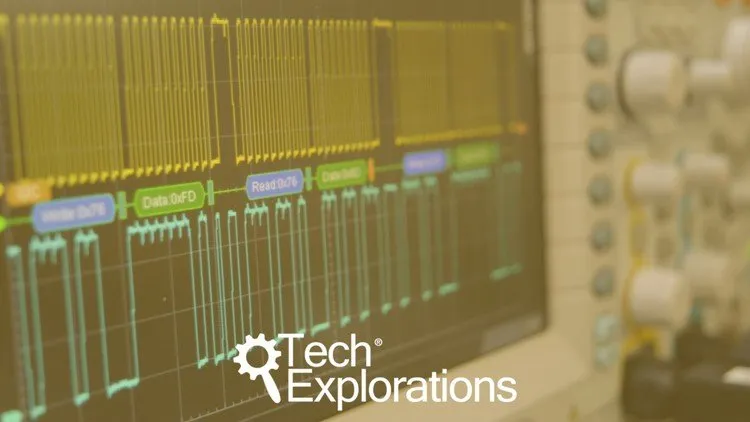Oscilloscopes for beginners
With this course, you will learn how to use the oscilloscope through a series of experiments

Oscilloscopes for beginners udemy course
With this course, you will learn how to use the oscilloscope through a series of experiments
What you'll learn:
- Understand the purpose of the oscilloscope.
- Understand the basic controls of the oscilloscope.
- Learn how to calibrate and use the probes so that a signal is transmitted to the oscilloscope with minimal distortion.
- Learn how to use the automatic and manual trigger function to capture a variety of signal types.
- Understand the differences and similarities between bench-top, portable and PC/USB oscilloscopes.
- Understand what you can and cannot do with an oscilloscope.
- Become familiar with the various kinds of waveforms that are typical in electronic circuits.
- Understand how to keep your oscilloscope and yourself safe.
- Learn how to use the oscilloscope automatic measurement and statistics functions.
- Learn how to take manual measurements using the cursors.
- Learn how to use cursors in manual, tracking and automatic mode.
- Build-up your skill and confidence through a series of experimentations.
Requirements:
- Basic electronics, i.e. able to use simple passive components like resistors and capacitors in a breadboard circuit, and understand the meaning of units like Volt, Amperes, and Hz.
- A working understanding of the Arduino Uno and the ESP32 as low-cost test signal generators, you should also be familiar with these platforms. We provide all circuit schematics and sketches in the course.
- You will need an oscilloscope. If you already have one, you can use it to practice the course experiments. If you don’t, you can purchase an inexpensive PC/USB oscilloscope for less than $100.
- To generate the test signals, we use an Arduino Uno and an ESP32, plus a few simple components like buttons, resistors, capacitors and a potentiometer. If you have completed Arduino Step by Step Getting Started and ESP32 For Busy People, you already have everything you need.
Description:
UPDATED January 20, 2020, with a new section and experiment.
----------------------------------------------------------------------------- Oscilloscopes for beginners Udemy
Oscilloscopes are incredible: They can capture, display, and analyse an electrical input signal. They can automatically produce all kinds of measurements, like the period, rise time, width, duty cycle, max and min voltages, and lots more, and even decode communications protocols like RS232, and I2C.
Are you working with electronics and are interested in using an oscilloscope to gain a better understanding of what is happening inside your circuits as they operate?
Perhaps you already have an oscilloscope but are confused by all its buttons, knobs and menu options?
Perhaps you are thinking of getting one but not sure if its worth it, or not sure what to look for?
This course is dedicated to the oscilloscope, and it will help you answer these questions, plus lots more.
It will teach you how to use the oscilloscope that you already have, or are planning to get.
After the multimeter, the oscilloscope is the most useful test instrument for makers.
Over the last few years, their prices have dropped by a lot, and it is now very common for students and hobbyists to be able to afford one. Today, budget scopes offer a full array of capabilities.
You are probably familiar with the multimeter. This test instrument gives you a snapshot of what is happening in your circuit in a specific moment in time. For example, it will tell you that the voltage on a certain pin is 5.1 Volts.
The multimeter works in a single dimension.
The oscilloscope works in two dimensions.
On its screen, it will plot the voltage of your test circuit over time. You can see how voltage changes over time, and get the measurements that describe various aspects of its operation. You can use this information to dive deep into the inner workings of your circuit.
This is a course for people who are already familiar with basic electronics.
To make the most from this course, you will need to have a working understanding of things like Volt, Hz and duty cycle.
Because I use the Arduino and the ESP32 to create experiments based on which I demonstrate various features and capabilities of the oscilloscope, you should also have a basic understanding of those two technologies.
In the course, first I’ll talk about the various aspects of an oscilloscope, such as the most important features, functions, and controls.
Second, I’ll help you get comfortable with your oscilloscope, calibrate it and get it ready for use.
And third, I’ll show you how to use the oscilloscope by guiding you through multiple experiments. Each experiment is an opportunity to learn and practice several new workflows and operations. This third part, the experimental, consists the bulk of the course.
So I invite you to enrol in this course right now, and learn how to use your oscilloscope.
You can also have a look at the free lectures for more information about the objectives and structure of this course.
Who this course is for:
- People who are ready to ready to move beyond their multimeter.
- People who are ready to dig deeper and understand what is going on in their circuits over time.
- People who want to understand what is an oscilloscope and how it works before they purchase one.
- People who already have an oscilloscope but are not sure how to use it.
- Machine Learning A-Z™: Hands-On Python & R In Data Science
- React - The Complete Guide (incl Hooks, React Router, Redux)
- Microsoft Excel - Excel from Beginner to Advanced
- Microsoft Excel - Advanced Excel Formulas & Functions
Course Details:
-
5.5 hours on-demand video
-
3 articles
-
Full lifetime access
-
Access on mobile and TV
-
Certificate of completion
Oscilloscopes for beginners udemy free download
With this course, you will learn how to use the oscilloscope through a series of experiments
Demo Link: https://www.udemy.com/course/oscilloscopes-for-beginners/

